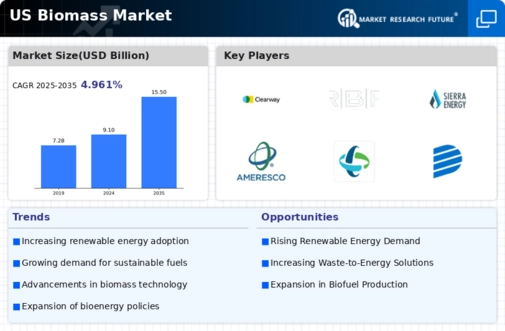The biomass market exhibits a dynamic competitive landscape characterized by a blend of innovation, sustainability initiatives, and strategic partnerships. Key players such as Enviva Holdings (US), Drax Group (GB), and Green Plains Inc. (US) are at the forefront, each adopting distinct strategies to enhance their market positioning. Enviva Holdings (US) focuses on expanding its production capacity and enhancing its supply chain efficiency, which appears to be a response to the increasing demand for renewable energy sources. Drax Group (GB) emphasizes digital transformation and operational efficiency, aiming to leverage technology to optimize biomass production processes. Meanwhile, Green Plains Inc. (US) is diversifying its portfolio by integrating biomass with its existing ethanol production, thereby creating synergies that could enhance profitability and sustainability.
The business tactics employed by these companies reflect a moderately fragmented market structure, where localized manufacturing and supply chain optimization are pivotal. The collective influence of these key players shapes the competitive environment, as they strive to meet the growing demand for biomass while navigating regulatory frameworks and sustainability goals. This competitive structure fosters innovation and encourages companies to adopt more efficient practices, ultimately benefiting the market as a whole.
In September 2025, Enviva Holdings (US) announced the opening of a new production facility in North Carolina, which is expected to increase its output by 30%. This strategic move not only enhances its production capabilities but also positions the company to better serve its customers in the southeastern US, where demand for biomass is surging. The facility is anticipated to create approximately 100 jobs, further solidifying Enviva's commitment to local economies and sustainable practices.
In October 2025, Drax Group (GB) unveiled a partnership with a leading technology firm to develop AI-driven solutions for optimizing biomass supply chains. This collaboration aims to enhance operational efficiency and reduce costs, which could provide Drax with a competitive edge in the market. By integrating advanced technologies, Drax is likely to improve its forecasting and inventory management, thereby minimizing waste and maximizing resource utilization.
In August 2025, Green Plains Inc. (US) completed the acquisition of a biomass processing facility in Nebraska, which is expected to bolster its production capacity by 25%. This acquisition aligns with Green Plains' strategy to diversify its offerings and enhance its sustainability profile. By integrating biomass into its operations, the company is poised to capitalize on the growing demand for renewable energy while reducing its carbon footprint.
As of November 2025, the biomass market is increasingly defined by trends such as digitalization, sustainability, and the integration of advanced technologies. Strategic alliances are becoming more prevalent, as companies recognize the importance of collaboration in achieving their sustainability goals. Looking ahead, competitive differentiation is likely to evolve, shifting from price-based competition to a focus on innovation, technology, and supply chain reliability. This transition may enable companies to better meet the demands of a rapidly changing market, ultimately fostering a more sustainable and resilient biomass sector.
























Leave a Comment